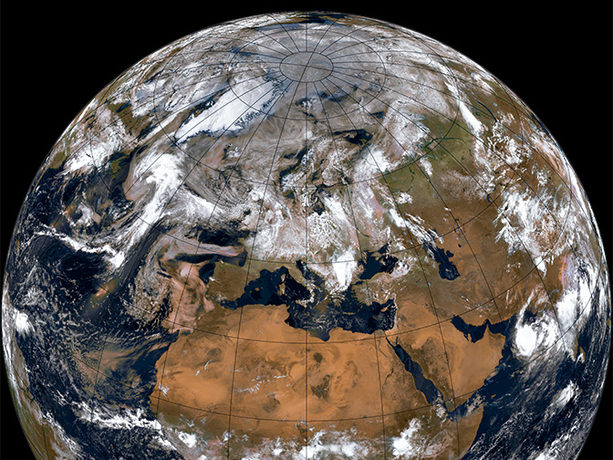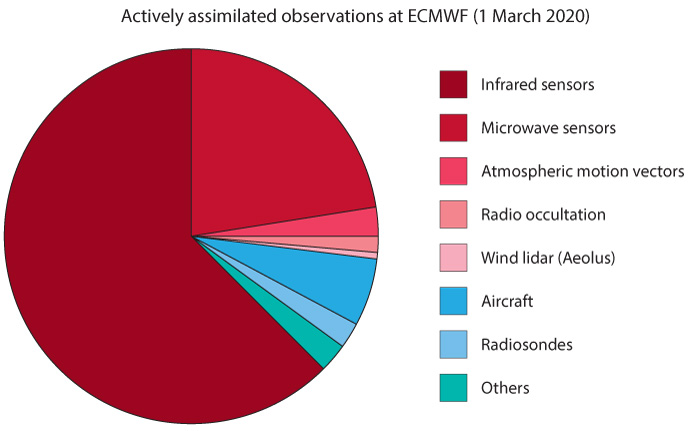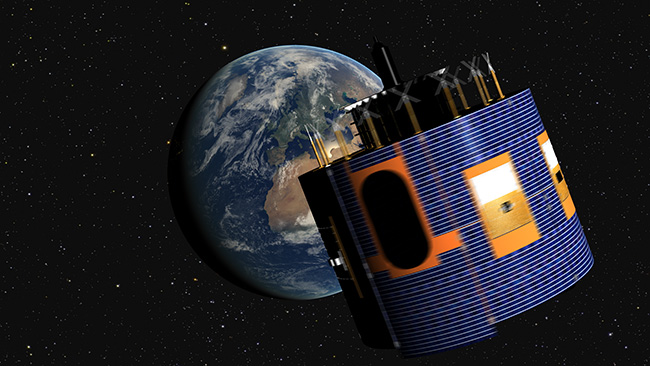Composite image of Earth as seen from EUMETSAT’s Metop-B weather
satellite in polar orbit at an altitude of 817 km.
(Copyright: 2016 EUMETSAT)
(Copyright: 2016 EUMETSAT)
From ECMWF
What is the role of satellite observations in weather forecasting?
Satellite observations make a crucial contribution to the quality of today’s weather forecasts.
Their global coverage means that they provide information on the atmosphere, the land surface, the ocean and sea ice that can’t be provided by in situ measurements.
Through a process called data assimilation, they help to produce the best possible estimate of the current state of the Earth system.
That estimate, called the analysis, is used as the initial conditions on which weather forecasts are based.
In addition, satellite data help to monitor the quality of forecasts and to identify and remedy deficiencies in the Earth system models used in weather forecasting.
What types of satellite observations are there?
Satellites carry passive instruments, which measure radiation emitted naturally, and active instruments, which send out signals and measure the backscatter.
Natural radiation contains information on, for instance, temperature, humidity, clouds and surface conditions.
It can also provide information on winds by tracing motions of humidity or cloud features in successive observations.
Active instruments use radar or lidar to probe the surface, clouds and winds.
Radio occultation observations are unique in that they involve sending signals from one satellite to another.
The bending angle of such signals crossing the troposphere or stratosphere depends on temperature and humidity.
How has the use of satellite observations at ECMWF evolved?
ECMWF’s use of satellite data has greatly increased over the last few decades.
Today such data collectively make the biggest contribution to forecast quality at ECMWF compared to other types of observations, such as weather station or aircraft data.
Satellite observations do not measure variables such as temperature or ocean wave height directly.
Instead, they measure quantities linked to these variables, such as radiances or radar echoes.
ECMWF has come to play a leading role in extracting the maximum amount of information from such observations.
How are radiances assimilated into ECMWF’s Earth system model?
Currently the vast majority of satellite data used at ECMWF come from passive instruments measuring infrared or microwave radiances.
Such radiances typically reflect conditions in a rather deep layer of the atmosphere and could be the result of any number of atmospheric states.
To be able to compare the observations with the state of the atmosphere in the forecasting model, we need to know what radiances would be observed if the model state correctly described the atmosphere.
Such simulated radiances are produced by what is known as an observation operator.
By comparing simulated radiances with observed ones, ECMWF’s 4D-Var data assimilation system can work out how the model state needs to be adjusted to pull it more closely towards the observations.
What is ‘all-sky’ satellite data assimilation?
ECMWF has pioneered the use of satellite observations of microwave radiances affected by clouds and precipitation.
Today such all-sky observations are routinely used at ECMWF and make a huge contribution to the quality of weather forecasts.
All-sky assimilation requires a good representation of raindrops, snowflakes and other hydrometeors in the model, and some knowledge of how they affect microwave radiances.
Only then can we successfully simulate the radiances a satellite instrument would measure if the state of the atmosphere corresponded to the model state.
Geostationary
satellites, such as this Meteosat Second Generation satellite, are in
orbit nearly 36,000 km above the Earth’s equator.
Active areas of research include the development of techniques to fully exploit hyperspectral infrared instruments, which have many thousands of channels; all-sky assimilation for infrared radiances; the use of more of the information that satellites provide on the wider Earth system, such as surface conditions, the ocean and atmospheric composition; and the treatment of random and systematic errors in satellite observations.
In addition, the Centre works on new generations of instruments with partners such as ESA and EUMETSAT in Europe and similar agencies in Japan, the US and China.
ECMWF has, for example, begun to assimilate Doppler wind lidar observations from ESA’s ground-breaking Aeolus satellite, and it is preparing the ground for the assimilation of cloud profile observations from the EarthCARE mission planned by ESA and the Japan Aerospace Exploration Agency (JAXA).
Links :



No comments:
Post a Comment